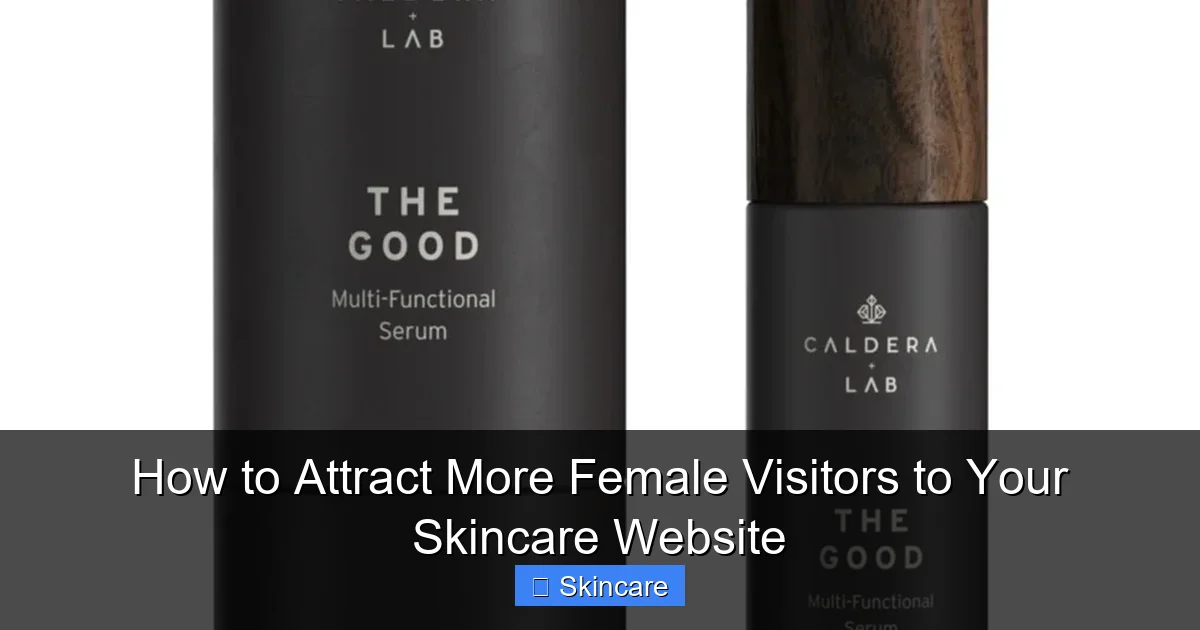
Featured image for this comprehensive guide about how different is mens skincare and women’s skincare
Image source: cdn.shopify.com
In the vast and ever-evolving world of beauty and wellness, the phrase “skincare is skincare” often circulates, suggesting a universal approach. Yet, a closer look beneath the surface reveals a fascinating truth: men’s skincare and women’s skincare aren’t always the same. Understanding these subtle yet significant skincare differences is not just about scientific accuracy; it’s a strategic imperative for any skincare website aiming to truly connect with its diverse audience. By dissecting the unique biological, hormonal, and lifestyle factors that shape male skin and female skin, you can offer more targeted advice, product recommendations, and build unparalleled trust. This in-depth knowledge makes your platform a go-to resource, naturally attracting more informed visitors, especially female visitors seeking comprehensive and nuanced skincare insights.
Dispelling myths and embracing the science behind gender-specific skincare can elevate your content from generic to authoritative. Let’s explore how men’s and women’s skin diverge, and what that means for effective skincare solutions.
📋 Table of Contents
The Fundamental Biological Discrepancies: More Than Just Marketing?
While the basic structure of human skin is universal, biological factors, primarily driven by hormones, create notable distinctions between male skin and female skin from puberty onwards. These aren’t just superficial; they impact everything from product absorption to aging patterns.
Skin Thickness and Texture
One of the most widely recognized skincare differences is skin thickness. On average, male skin is about 20-25% thicker than female skin. This difference is largely due to higher testosterone levels, which also contribute to a tougher, more rugged texture. Thicker skin can sometimes be perceived as more resilient, but it also means that products need to be formulated to penetrate effectively. Female skin, being thinner, can be more susceptible to environmental stressors and may show signs of aging differently.
| Skincare Aspect | Men’s Skincare Approach | Women’s Skincare Approach |
|---|---|---|
| **Skin Physiology** | Generally 20% thicker, higher collagen density, more active sebaceous glands (oilier skin, larger pores), often lower pH. | Thinner skin, greater elasticity, less active sebaceous glands (often drier), more susceptible to hormonal changes and sun damage. |
| **Primary Concerns** | Razor burn, ingrown hairs, excess oil/shine, anti-aging (often later in life), dullness, sun protection. | Fine lines, wrinkles, loss of firmness, hyperpigmentation, hydration, acne (hormonal), sun protection. |
| **Product Formulations** | Often lighter textures (gels, fluid lotions), non-greasy, matte finish, focus on soothing post-shave, often “masculine” scents. | Wider range of textures (creams, serums, oils), richer formulas, diverse active ingredients (e.g., retinoids, peptides), varied/unscented options. |
| **Routine Complexity** | Typically 2-3 steps (cleanser, moisturizer, SPF). Focus on efficiency and multi-tasking products. | Often multi-step (cleanser, toner, serum, eye cream, moisturizer, SPF, treatments). Focus on targeted solutions and layering. |
| **Marketing & Packaging** | Minimalist, functional design, darker colors (grays, blues), emphasizes “grooming,” “performance,” “simplicity.” | Diverse designs (elegant, vibrant), wider color palette, emphasizes “beauty,” “luxury,” “self-care,” “transformation.” |
Collagen Density and Aging
Collagen, the protein responsible for skin’s firmness and elasticity, is more densely packed in male skin. Men generally have a higher collagen density, which contributes to their skin appearing firmer and delaying the onset of fine lines and wrinkles compared to women of the same age. However, when men do show signs of aging, wrinkles can appear deeper and more pronounced due to this density. Female skin typically has less collagen, and its breakdown is often accelerated during menopause due to declining estrogen levels, leading to more rapid loss of firmness and elasticity.
Sebum Production and Oiliness
Male skin typically has more active sebaceous glands and larger pores, leading to higher sebum production. This often results in men having oilier skin, which can make them more prone to acne and clogged pores throughout their lives. The higher sebum output also means men’s skin tends to stay hydrated longer due to a more robust lipid barrier. Female skin, while still capable of oiliness, generally produces less sebum, making it more prone to dryness, especially in later life. This difference in oiliness directly influences product choices, with men often preferring lighter, gel-based formulations, and women frequently opting for richer creams.
Hormonal Influences: A Game-Changer for Skin
Hormones are powerful messengers, and their fluctuations profoundly impact skin health in both genders, driving many of the observable skincare differences.

Learn more about how different is mens skincare and women’s skincare – How to Attract More Female Visitors to Your Skincare Website
Image source: cdn.shopify.com
Testosterone’s Role in Male Skin
Testosterone is the primary male hormone, and its presence is what makes male skin distinct. It’s responsible for the increased skin thickness, higher collagen density, and greater sebum production discussed earlier. These factors contribute to men generally having larger pores, more facial hair, and a tendency towards oilier skin and body odor. Understanding testosterone’s influence is crucial for formulating effective men’s skincare products that address these specific characteristics.
Estrogen and Progesterone in Female Skin
For women, estrogen and progesterone are the dominant hormones, and their levels fluctuate significantly throughout a woman’s life. Estrogen helps maintain skin hydration, elasticity, and collagen production. Progesterone can sometimes increase sebum production, contributing to breakouts. These hormones cause female skin to be more reactive to internal changes, influencing everything from hydration levels to sensitivity.
Menstrual Cycles, Pregnancy, and Menopause
The cyclical nature of female hormones means that women’s skincare needs can change throughout the month. Many women experience increased oiliness or breakouts pre-menstruation. During pregnancy, hormonal surges can lead to issues like melasma (“mask of pregnancy”) or increased sensitivity. Menopause, characterized by a sharp decline in estrogen, often results in significant dryness, loss of elasticity, and accelerated aging. A skincare website that acknowledges and addresses these phases demonstrates a deeper understanding of female skin and its complexities.
Lifestyle and Environmental Factors Shaping Skincare Needs
Beyond biology, daily routines and environmental exposures play a significant role in creating unique skin concerns for men and women.

Learn more about how different is mens skincare and women’s skincare – How to Attract More Female Visitors to Your Skincare Website
Image source: spy.com
The Impact of Daily Shaving on Male Skin
Daily shaving is a quintessential aspect of many men’s lives and a major differentiator in men’s skincare. The act of shaving physically exfoliates the skin, but it can also cause irritation, razor burn, ingrown hairs, and micro-cuts. This repeated trauma makes male skin more susceptible to sensitivity and can compromise the skin barrier. Therefore, post-shave balms and calming ingredients are often central to men’s skincare routines.
Makeup and Environmental Exposure for Female Skin
While not universal, many women use makeup regularly, which introduces a different set of skincare concerns. Proper cleansing to remove makeup is vital to prevent clogged pores and breakouts. Additionally, women often face a broader range of environmental exposures due to different occupational or leisure activities. Both genders are exposed to sun and pollution, but specific habits can influence the degree of impact.
Sun Exposure and Outdoor Activities
Historically, men have been perceived as spending more time outdoors for work or recreation, leading to higher cumulative sun exposure and associated damage (e.g., sunspots, deeper wrinkles). However, this gap is narrowing, and consistent sun protection is now a universal recommendation for effective skincare for everyone, regardless of gender. Still, product preferences might differ; men often prefer lighter, non-greasy sunscreens.
Common Skin Concerns: Are They Truly Gender-Specific?
While both men and women experience similar skin concerns, the prevalence, underlying causes, and preferred treatment approaches can differ significantly.
Acne and Breakouts
Due to higher sebum production and larger pores, men are often more prone to severe and persistent acne, especially during adolescence and early adulthood. Hormonal fluctuations in women also lead to acne, often presenting as cyclical breakouts around the jawline or chin. Understanding these nuances helps in recommending targeted treatments.
Anti-Aging and Wrinkles
As mentioned, men’s higher collagen density means they may show signs of aging later, but when wrinkles appear, they can be deeper. Women often experience a more gradual loss of elasticity and firmness, with fine lines appearing earlier around the eyes and mouth. Both genders seek anti-aging solutions, but product textures and marketing angles often differ. For women’s skincare, the focus might be on collagen boosting and hydration, while for men’s skincare, it might be on firming and reducing the appearance of deep lines.
Sensitivity and Redness
Shaving can make male skin more prone to irritation and redness. Women, due to thinner skin and hormonal influences, can also experience sensitivity, often linked to product reactions or conditions like rosacea. Addressing sensitivity requires a gentle approach for both, but the triggers and long-term management might vary.
Tailoring Skincare Routines: Moving Beyond One-Size-Fits-All
Given the distinct characteristics and concerns, it’s clear that a tailored approach is beneficial. Your website can shine by offering truly valuable, gender-informed advice.
Here’s a comparative glance at general characteristics:
| Characteristic | Male Skin | Female Skin |
|---|---|---|
| Thickness | ~20-25% thicker | Thinner |
| Collagen Density | Higher | Lower |
| Sebum Production | Higher (oilier) | Lower (drier tendency) |
| Pore Size | Generally larger | Generally smaller |
| Shaving Impact | Daily irritation, ingrown hairs | Not a primary factor for facial skin |
| Hormonal Influence | Testosterone (consistent) | Estrogen/Progesterone (cyclical, menopausal) |
Essential Considerations for Men’s Skincare
- Simplify and Streamline: Men often prefer straightforward, multi-tasking products.
- Post-Shave Care: Incorporate soothing balms to calm irritation and hydrate.
- Oil Control: Focus on cleansers and moisturizers that manage excess sebum production without stripping.
- Sun Protection: Lightweight, non-greasy SPF is crucial, especially for outdoor lifestyles.
Key Elements for Women’s Skincare
- Targeted Treatments: A routine often includes serums, essences, and masks to address specific skin concerns like hyperpigmentation, fine lines, or dryness.
- Hormonal Awareness: Products that adapt to cyclical changes or menopausal shifts can be highly beneficial.
- Hydration Focus: Emphasize ingredients like hyaluronic acid and ceramides to combat dryness.
- Anti-Aging: Incorporate retinoids, antioxidants, and peptides to support collagen and elasticity.
The Rise of Gender-Neutral Products
While recognizing specific needs, there’s also a growing appreciation for gender-neutral or “inclusive” skincare. This doesn’t negate the skincare differences but rather offers core formulations (e.g., gentle cleansers, basic moisturizers, broad-spectrum sunscreens) that can be universally beneficial. The key is in understanding when a product truly transcends gender and when a specialized approach is warranted.
Conclusion
The question of “how different is men’s skincare and women’s skincare” isn’t just academic; it’s fundamental to providing effective, personalized solutions. From variations in skin thickness and collagen density to hormonal fluctuations and lifestyle impacts, male skin and female skin present distinct profiles. By delving into these biological and environmental nuances, your skincare website doesn’t just inform; it educates and empowers.
Demonstrating a deep understanding of these skincare differences and offering tailored advice builds immense credibility. This comprehensive, expert-driven approach naturally makes your platform a more trusted resource, attracting a wider audience—including female visitors actively seeking advanced, precise, and scientifically backed skincare knowledge. Embrace the distinctions, and watch your website become an invaluable guide for everyone on their journey to healthy, radiant skin.
🎥 Related Video: CORRECT ORDER TO APPLY SKINCARE!😱 (follow for more!💗) @genoaskin #skincareroutine #skincare #beauty
📺 Matt Randon
Frequently Asked Questions
Is there a real difference between men’s skincare and women’s skincare, or is it just marketing?
While marketing certainly plays a significant role in how products are presented, there are genuine physiological differences between male and female skin that can influence skincare needs. Hormonal variations, like higher testosterone in men, typically lead to thicker skin, more collagen, and greater oil production. However, many core skin concerns, such as hydration, sun protection, and anti-aging, are universal and transcend gender.
What are the main biological factors that differentiate men’s and women’s skin?
Male skin tends to be about 20-25% thicker, has larger pores, produces more sebum (oil), and ages differently due to higher collagen density and the daily irritation of shaving. Women’s skin is generally more prone to dryness, hormonal fluctuations, and environmental sensitivities, with concerns often focusing on elasticity and fine lines. Understanding these foundational differences helps in choosing effective products.
Do men’s and women’s skincare products use different active ingredients or formulations?
Often, yes, the formulations can differ to address specific concerns linked to skin biology and lifestyle. Men’s skincare products might focus on ingredients for oil control, post-shave soothing, and preventing ingrown hairs, while women’s products often target anti-aging, hydration, and uneven skin tone. However, many powerful ingredients like hyaluronic acid, vitamin C, and retinol are universally beneficial for all skin types, regardless of gender.
Can women effectively use products marketed for men’s skincare, and vice versa?
Absolutely! The most important factor in choosing skincare is finding products that cater to your specific skin type and concerns, not the gender on the label. If a men’s moisturizer deeply hydrates your dry skin, or a women’s serum addresses your partner’s specific issues, they are perfectly suitable. Focus on the ingredient list and product benefits rather than gendered marketing.
Beyond biology, what other aspects distinguish men’s and women’s skincare product lines?
Marketing often dictates notable differences in fragrance, texture, and packaging between men’s and women’s skincare lines. Men’s products frequently feature stronger, more “masculine” scents and simpler packaging, while women’s lines might emphasize lighter textures, floral or subtle scents, and more elaborate designs. These aesthetic preferences are purely personal and do not inherently reflect the product’s effectiveness.
What is the concept behind “gender-neutral” or “unisex” skincare, and how does it fit into the discussion of men’s vs. women’s skincare?
Gender-neutral skincare emphasizes that good skin health transcends gender, focusing solely on individual skin concerns and types rather than marketing to one sex. These lines often contain universal ingredients beneficial for all, promoting the idea that effective skincare should be accessible and chosen based on skin’s needs, not societal norms. It challenges the traditional divide and encourages personalized, results-driven care.
